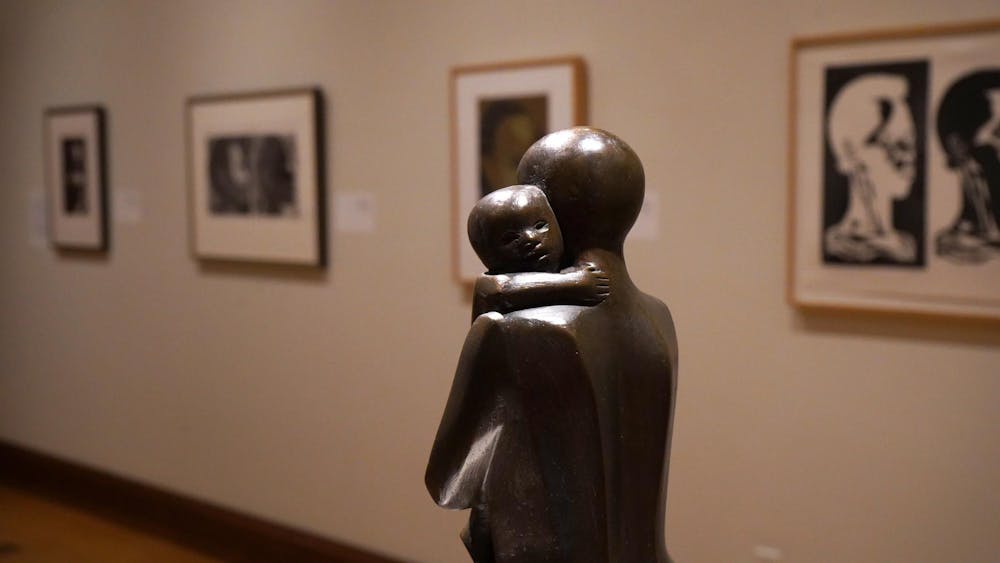From her versatile mediums and strong topics, the art of Elizabeth Catlett commands your attention. Ball State University’s David Owsley Museum of Art (DOMA) is hosting her work in its fall exhibition, “The Art of Elizabeth Catlett from the Collection of Samella Lewis.”
Making itself a temporary home at Ball State University, the collection of art features prolific African-American artist Elizabeth Catlett and is curated by her student and friend, Samella Lewis. Catlett’s work is a spectrum, containing a variety of different themes and styles.
“She does the whole gamut, from abstract to realism,” DOMA Director Robert LaFrance said.
The exhibit focuses on topics like the strength of Black women, Afrofemcentrism, Black power and the Civil Rights Movement.
Catlett, originally from Washington, D.C., attended Howard University in 1931. After teaching art post-university, she returned to being a student. Catlett went on to the University of Iowa, becoming the first to graduate with a master of fine arts from the institution.
While her original degree was focused on printmaking, design, and drawing, her masters widened her abilities to include painting and sculpture.
While at the University of Iowa, Catlett studied under and was inspired by American Regionalist painter Grant Wood. It was at this time that she began working more heavily with wood and bronze sculpture, similar to pieces featured in the DOMA exhibition.
Chair of the Department of Women’s Gender and African American Studies and professor of English Sharon Jones said the work of Catlett emphasizes the depth, complexity, nuance and importance of marginalized groups.
“So much of her art resonates with her interest in a variety of topics, but one of the things I appreciate about her art is the way she often centered groups of people who had often been relegated to the sidelines,” Jones said.
The exhibit includes pieces like “The Sharecropper,” as well as many others, but Catlett’s work is not alone in this exhibit. To connect Catlett to her influences and paint a larger picture to present in the exhibit, LaFrance paired her work with those she learned from, was inspired by and also taught.
Some of which were pieces by Mexican muralists.
“The reason [Catlett] went to Mexico in the first place was to see works by the Mexican muralists,” LaFrance said. “We have a couple of really nice things, with one by Rivera and the other by Siqueiros.”
Her trip to Mexico was not intended to be long, but eventually, she moved there in 1947, marrying Mexican muralist Francisco Mora.
Muralists had a major focus on political and social ideas and shifting public views, which aligned with Catlett. Although residing in Mexico at the time, Catlett stayed aware of U.S. movements in the 1960s and 1970s, such as the Black Power movement. Her alignment eventually barred her from entering the U.S., and her citizenship was not reinstated until 2002.
Mya Whitis, museum education and collections intern and docent, explained what the exhibition means to her as well as the feelings and conversations she believes it can start.
“To have these prints that are very dignified and tell our history and our story, but also do it in a way that’s not just ‘Hey, we’re angry’, but here’s why we’re angry,” Whitis said. “I think that is priceless.”
Whitis believes that the exhibition can do more than just tell a story, but spark real and important conversations about the topics presented at a crucial time.
“Especially with the election coming up having a show that stirs that type of feeling, and most importantly, conversations among students, it's just absolutely necessary,” Whitis said.
Jones highlighted that the exhibition and its provoking topics can give viewers a chance to confront history in a different way than they may be able to typically.
“I think that confronting it through art can be very moving,” Jones said. “There’s a lot of ways to confront history, and I think that works of art will often make people unpack, explore, examine and discuss what it means to them.”
DOMA adds various interactive activities to its exhibitions to increase learning and engagement, Catlett’s exhibition is no different. At the exit of the exhibit, visitors will find a room with walls full of various questions, encouraging you to take a sticky note and write your answer.
The questions revolve around the idea of radical empathy, coined by author Terri Givens in 2021. Givens defines her term in the synopsis of her book “Radical Empathy”.
“Radical empathy – moving beyond an understanding of others’ lives and pain to understand the origins of our biases, including internalized oppression,” Givens said.
Whitis honed in on a specific question which asked “Who is a woman you look up to?”
“I saw three post-its that said ‘my mom,’ and I thought that was really important,” Whitis said. “The fact that the show is so consistent in its message that you can go to the show and all of a sudden have a deeper understanding of past generations and how this affects them and you. ”
The purpose of these questions is, much like the pieces in the exhibit, to encourage conversation and thought around the topics presented.
“I hope people come and see the show, look at the art, begin to understand it and practice a little radical empathy before and after they leave,” LaFrance said.
The exhibition is open at DOMA during the museum's regular hours, running until December 20. It will be closed from November 27 to December 2 for Thanksgiving break.
Contact Madelyn Bracken via email at madelyn.bracken@bsu.edu.





